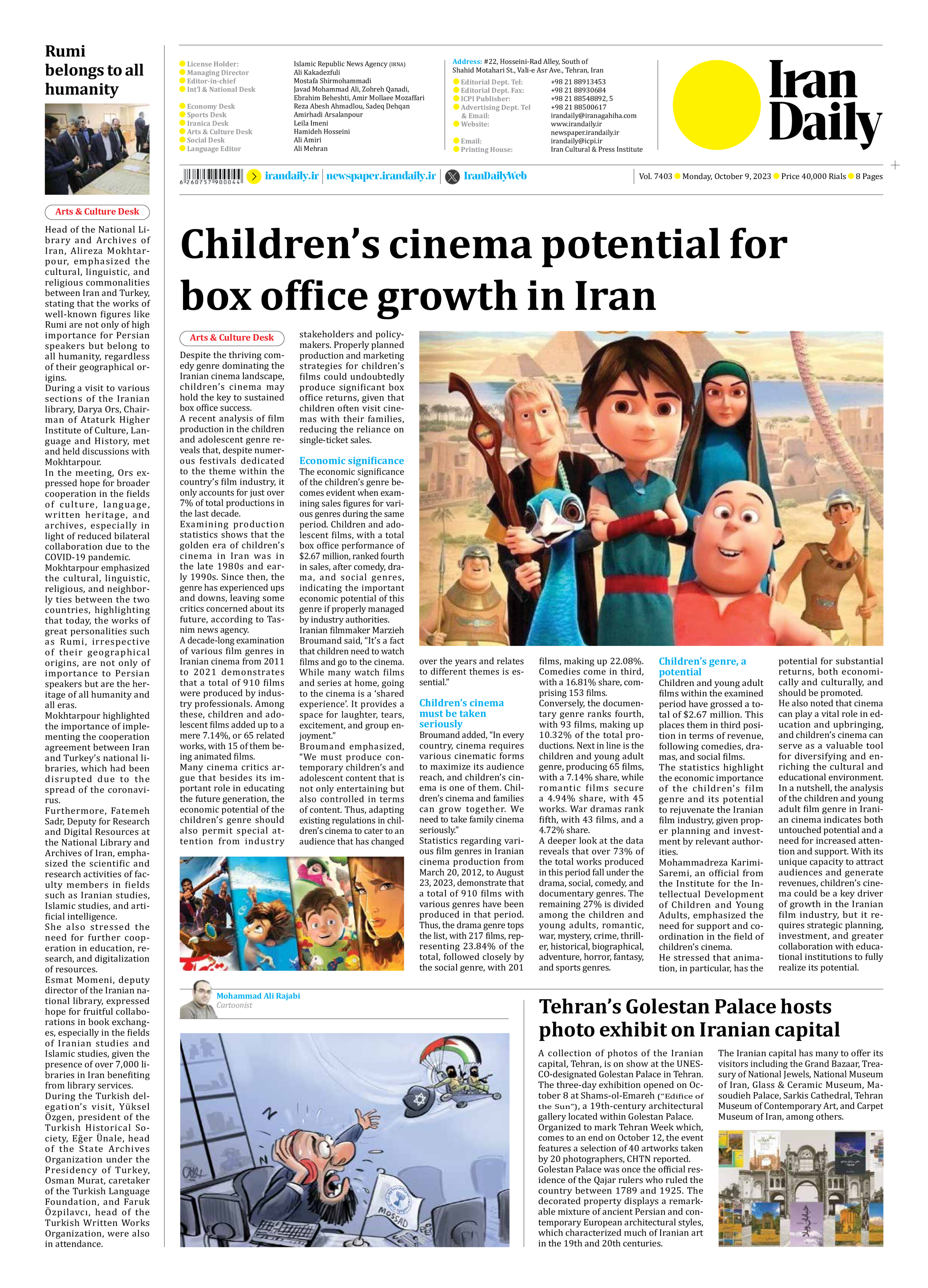
Children’s cinema potential for box office growth in Iran
Despite the thriving comedy genre dominating the Iranian cinema landscape, children’s cinema may hold the key to sustained box office success.
A recent analysis of film production in the children and adolescent genre reveals that, despite numerous festivals dedicated to the theme within the country’s film industry, it only accounts for just over 7% of total productions in the last decade.
Examining production statistics shows that the golden era of children’s cinema in Iran was in the late 1980s and early 1990s. Since then, the genre has experienced ups and downs, leaving some critics concerned about its future, according to Tasnim news agency.
A decade-long examination of various film genres in Iranian cinema from 2011 to 2021 demonstrates that a total of 910 films were produced by industry professionals. Among these, children and adolescent films added up to a mere 7.14%, or 65 related works, with 15 of them being animated films.
Many cinema critics argue that besides its important role in educating the future generation, the economic potential of the children’s genre should also permit special attention from industry stakeholders and policymakers. Properly planned production and marketing strategies for children’s films could undoubtedly produce significant box office returns, given that children often visit cinemas with their families, reducing the reliance on single-ticket sales.
Economic significance
The economic significance of the children’s genre becomes evident when examining sales figures for various genres during the same period. Children and adolescent films, with a total box office performance of $2.67 million, ranked fourth in sales, after comedy, drama, and social genres, indicating the important economic potential of this genre if properly managed by industry authorities.
Iranian filmmaker Marzieh Broumand said, “It’s a fact that children need to watch films and go to the cinema. While many watch films and series at home, going to the cinema is a ‘shared experience’. It provides a space for laughter, tears, excitement, and group enjoyment.”
Broumand emphasized, “We must produce contemporary children’s and adolescent content that is not only entertaining but also controlled in terms of content. Thus, adapting existing regulations in children’s cinema to cater to an audience that has changed over the years and relates to different themes is essential.”
Children’s cinema must be taken seriously
Broumand added, “In every country, cinema requires various cinematic forms to maximize its audience reach, and children’s cinema is one of them. Children’s cinema and families can grow together. We need to take family cinema seriously.”
Statistics regarding various film genres in Iranian cinema production from March 20, 2012, to August 23, 2023, demonstrate that a total of 910 films with various genres have been produced in that period. Thus, the drama genre tops the list, with 217 films, representing 23.84% of the total, followed closely by the social genre, with 201 films, making up 22.08%. Comedies come in third, with a 16.81% share, comprising 153 films.
Conversely, the documentary genre ranks fourth, with 93 films, making up 10.32% of the total productions. Next in line is the children and young adult genre, producing 65 films, with a 7.14% share, while romantic films secure a 4.94% share, with 45 works. War dramas rank fifth, with 43 films, and a 4.72% share.
A deeper look at the data reveals that over 73% of the total works produced in this period fall under the drama, social, comedy, and documentary genres. The remaining 27% is divided among the children and young adults, romantic, war, mystery, crime, thriller, historical, biographical, adventure, horror, fantasy, and sports genres.
Children’s genre, a potential
Children and young adult films within the examined period have grossed a total of $2.67 million. This places them in third position in terms of revenue, following comedies, dramas, and social films.
The statistics highlight the economic importance of the children’s film genre and its potential to rejuvenate the Iranian film industry, given proper planning and investment by relevant authorities.
Mohammadreza Karimi-Saremi, an official from the Institute for the Intellectual Development of Children and Young Adults, emphasized the need for support and coordination in the field of children’s cinema.
He stressed that animation, in particular, has the potential for substantial returns, both economically and culturally, and should be promoted.
He also noted that cinema can play a vital role in education and upbringing, and children’s cinema can serve as a valuable tool for diversifying and enriching the cultural and educational environment.
In a nutshell, the analysis of the children and young adult film genre in Iranian cinema indicates both untouched potential and a need for increased attention and support. With its unique capacity to attract audiences and generate revenues, children’s cinema could be a key driver of growth in the Iranian film industry, but it requires strategic planning, investment, and greater collaboration with educational institutions to fully realize its potential.







